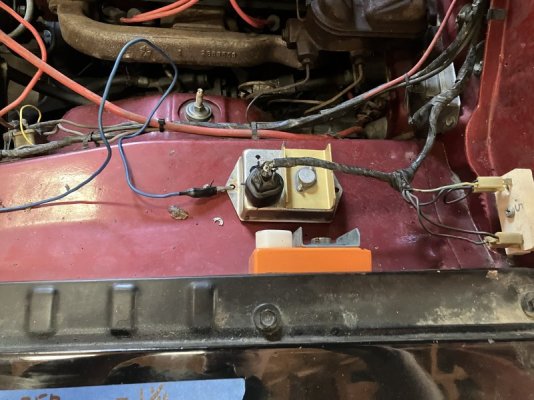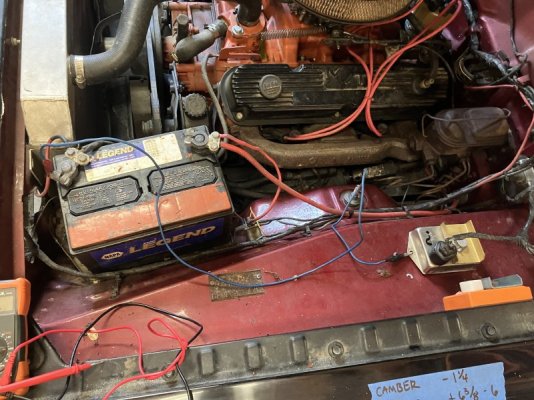gtx6970
Well-Known Member
Now that was funny.Five cents worth.... (exchange rates are brutal)
Now that was funny.Five cents worth.... (exchange rates are brutal)
Be careful..
Testing an ECU is a challenging task...
Its key component is the power transistor


A power transistor can have what called "secondary breakdown" and its internal silicon shorts out under current/voltage load..
As I posted previously secondary breakdown is a common failure mode with bi-polar power transistors..I agree. I had hoped that this manual would have been a little more detailed in that :
View attachment 1717562
The only test I could find pertains to this:
View attachment 1717563
To test, I grounded the case. I then attached the probes to #5 pin, then battery ground on this unit:
View attachment 1717564
This ECU was pulled from my Charger last night when the car wouldn’t start. It actually showed .2 ohms when I tested it today.
View attachment 1717565
View attachment 1717566
In the Duster, it started and idled but popped and stumbled when I revved it up. I can only imagine how it would be in gear out on the road.
If I am understanding this right, this means a failing component can work under light load but fail under higher load? If so, that is what seemed to happen here.
No offense to others here but I want to be better than I’ve been in the past. The habit of swapping parts until something works feels like the work of the guy that doesn’t know what to do. I want to be able to diagnose better.
If I didn’t have 10 ECUs, numerous ballast resistors and coils to swap around, I’d be at the parts store buying stuff to fix something that wasn’t broken.
The blue “Hi Rev 7500” ECU failed last month. It had proper grounding but conked out at the exact same time the ballast resistor failed. Is it possible that one led to the other? If so, why? Did the dying ECU burn up the ballast or did intermittent failures from the ballast cook the ECU?
Nothing about my combination is unusual. I run a stock based alternator that shows a 13.5+ charge according to the volt meter. The battery is in the trunk. I am well grounded at all points. The only Piccadilly about this car is the occasional failures in the ignition system.


 www.forabodiesonly.com
www.forabodiesonly.com

 www.forabodiesonly.com
www.forabodiesonly.com
First hi rev I have heard of fail. Yes the ecu if internally shorted will blow the ballast like a fuse. Biggest thing with any ignition is to have the matching parts, Ballast resistors at the parts store do not list how many ohms kind of a crap shoot there. Here is an example of matching. Do not run the HP on the street with those ballast, they are designed to cool off between 1/4 runs.I agree. I had hoped that this manual would have been a little more detailed in that :
View attachment 1717562
The only test I could find pertains to this:
View attachment 1717563
To test, I grounded the case. I then attached the probes to #5 pin, then battery ground on this unit:
View attachment 1717564
This ECU was pulled from my Charger last night when the car wouldn’t start. It actually showed .2 ohms when I tested it today.
View attachment 1717565
View attachment 1717566
In the Duster, it started and idled but popped and stumbled when I revved it up. I can only imagine how it would be in gear out on the road.
If I am understanding this right, this means a failing component can work under light load but fail under higher load? If so, that is what seemed to happen here.
No offense to others here but I want to be better than I’ve been in the past. The habit of swapping parts until something works feels like the work of the guy that doesn’t know what to do. I want to be able to diagnose better.
If I didn’t have 10 ECUs, numerous ballast resistors and coils to swap around, I’d be at the parts store buying stuff to fix something that wasn’t broken.
The blue “Hi Rev 7500” ECU failed last month. It had proper grounding but conked out at the exact same time the ballast resistor failed. Is it possible that one led to the other? If so, why? Did the dying ECU burn up the ballast or did intermittent failures from the ballast cook the ECU?
Nothing about my combination is unusual. I run a stock based alternator that shows a 13.5+ charge according to the volt meter. The battery is in the trunk. I am well grounded at all points. The only Piccadilly about this car is the occasional failures in the ignition system.
Especially with one that has bi-polar secondary break downsI have read this whole thread and still dont know how to get a high resistance woman hot
